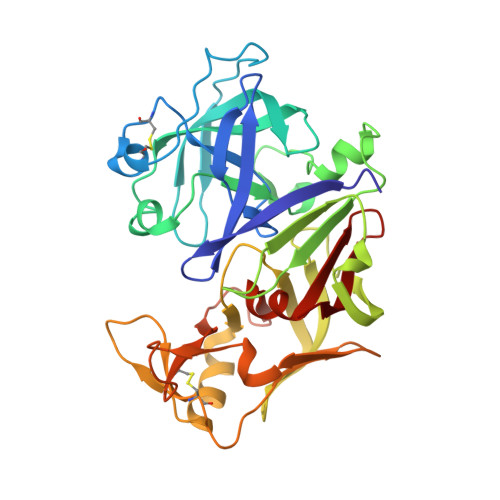Structure of the aspartic protease plasmepsin 4 from the malarial parasite Plasmodium malariae bound to an allophenylnorstatine-based inhibitor.
Clemente, J.C., Govindasamy, L., Madabushi, A., Fisher, S.Z., Moose, R.E., Yowell, C.A., Hidaka, K., Kimura, T., Hayashi, Y., Kiso, Y., Agbandje-McKenna, M., Dame, J.B., Dunn, B.M., McKenna, R.(2006) Acta Crystallogr D Biol Crystallogr 62: 246-252
- PubMed: 16510971
- DOI: https://doi.org/10.1107/S0907444905041260
- Primary Citation of Related Structures:
2ANL - PubMed Abstract:
The malarial parasite continues to be one of the leading causes of death in many developing countries. With the development of resistance to the currently available treatments, the discovery of new therapeutics is imperative. Currently, the plasmepsin enzymes found in the food vacuole of the parasite are a chief target for drug development. Allophenylnorstatine-based compounds originally designed to inhibit HIV-1 protease have shown efficacy against all four plasmepsin enzymes found in the food vacuole of Plasmodium falciparum. In this study, the first crystal structure of P. malariae plasmepsin 4 (PmPM4) bound to the allophenylnorstatine-based compound KNI-764 is described at 3.3 Angstroms resolution. The PmPM4-inhibitor complex crystallized in the orthorhombic space group P2(1)2(1)2, with unit-cell parameters a = 95.9, b = 112.6, c = 90.4 Angstroms, with two molecules in the asymmetric unit related by a non-crystallographic symmetry operator. The structure was refined to a final R factor of 24.7%. The complex showed the inhibitor in an unexpected binding orientation with allophenylnorstatine occupying the S1' pocket. The P2 group was found outside the S2 pocket, wedged between the flap and a juxtaposed loop. Inhibition analysis of PmPM4 also suggests the potential for allophenylnorstatine-based compounds to be effective against all species of malaria infecting humans and for the future development of a broad-based inhibitor.
Organizational Affiliation:
Department of Biochemistry and Molecular Biology, College of Medicine, University of Florida, USA.















